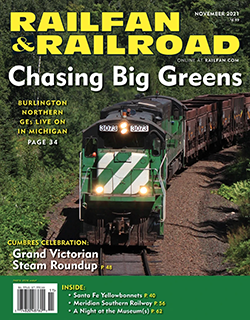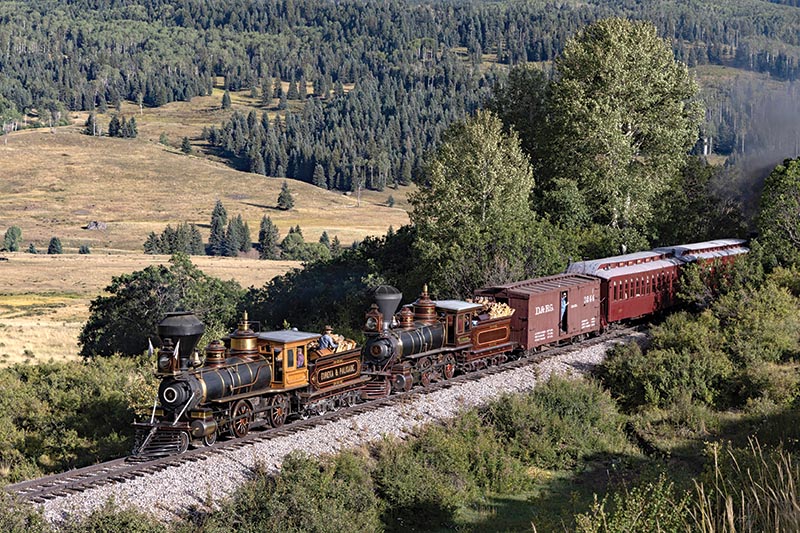 This past September, Cumbres & Toltec Scenic Railroad marked 50 years of its founding as a heritage railway in southern Colorado and northern New Mexico. To celebrate, it held what it called the “Victorian Iron Horse Roundup,” bringing together four narrow-gauge steam locomotives from across the west, each built in the last quarter of the 19th century (see page 48). These locomotives are remarkable machines that help us understand railroading’s past, but they also raise a question: What does historical actually mean? Sure, it seems safe to say that the last three decades of the 19th century may be historic… but what about the last three decades of the 20th?
This past September, Cumbres & Toltec Scenic Railroad marked 50 years of its founding as a heritage railway in southern Colorado and northern New Mexico. To celebrate, it held what it called the “Victorian Iron Horse Roundup,” bringing together four narrow-gauge steam locomotives from across the west, each built in the last quarter of the 19th century (see page 48). These locomotives are remarkable machines that help us understand railroading’s past, but they also raise a question: What does historical actually mean? Sure, it seems safe to say that the last three decades of the 19th century may be historic… but what about the last three decades of the 20th?
Let me make a case. Consider for a moment that one-quarter of all Americans were born in this, the 21st century. Fewer than half of all Americans remember a world before Amtrak, deregulation, and the replacement of cabooses with the coupler-mounted flashing rear end device, let alone steam power.
Historians have long debated where the present ends and the past begins. Having some distance from the past helps provide researchers with perspective, but how far is enough? Further, enough time must have passed for records to make their way into archives, libraries, and other places that scholars can access. As a result, 25 years is a common rule-of-thumb for when the past becomes potentially “historical.”
People who preserve buildings take a slightly longer view. For example, U.S. law restricts additions to the National Register of Historic Places to buildings that are at least 50 years old. Consider, though, that very soon that will be 1972. Something as humdrum as an SD40-2, an Amfleet I coach, or a 50-foot Railbox could soon qualify for federal protections alongside the 19th century locomotives that made a grand show in Chama.
It is difficult to come to grips with parts of your everyday life becoming the material of museums. Nostalgia for your own past is one thing, but having that past become public nostalgia is quite another. The flipside, though, is just as tough to deal with.
More than 20 years ago, a teenager named Chris Fussell took to the internet to lobby for preserving one of Amtrak’s once-large fleet of F40PH locomotives. Posting on a number of train-themed internet bulletin boards, he managed to raise enough support to secure the 1977-built Amtrak 231. Despite this success, however, Fussell was subject to significant derision and scorn. Many railfans made fun of his taste in locomotives, dismissing the effort as a vanity project of a youth with no perspective on what was truly historic. In retrospect, Fussell seems the visionary here. Amtrak retired all of its F40s by the end of 2003, and today, 231 is one of only three of these Amtrak locomotives in preservation.
Consider the EMD E7-A. At 428 units, it was the best-selling passenger locomotive in U.S. history, common from coast to coast. But that, it seems, was its downfall. As they aged and neared retirement in the 1960s, the E7-As almost imperceptibly filtered into scrapyards. What was once common is suddenly endangered, what was taken for granted or even dismissed as dull, boring, and without value is transformed into someone else’s treasure, at risk of loss forever. Only one was saved, Pennsylvania 5901, now displayed at the Railroad Museum of Pennsylvania at Strasburg. If only someone had the foresight to save such a boring, everyday thing back in 1970!
The iron, steam, and steel of the Victorian Iron Horse Roundup were all remarkable, but do not be fooled. Once, nobody cared for these either. It may be uncomfortable to feel our yesterdays become history, but for the sake of the future, we’d better get used to it. Now, who will preserve an SD70ACe?
—Contributing Editor Alexander Benjamin Craghead is a transportation historian, photographer, artist, and author.



